Ten years ago, the world was deep in the grip of a new film obsession called “Twilight,” released on November 21, 2008.
While the four-book series by Stephenie Meyer about the romance between a human teenager and a vampire was already extremely popular with its audience of teenage girls (and at times older women who were affectionately called “Twimoms”), the film opened it up to as-yet-untapped fans. With the good looks of Robert Pattinson and Kristen Stewart gazing out from posters, the “Twilight” universe multiplied its fanbase tenfold.
Which also, naturally, opened up the fandom to as-yet unprecedented levels of hate. The book series had attracted some ire but mostly flown under the radar, whereas the worldwide, mainstream obsession with “Twilight” that followed the film’s release attracted more haters than anyone could expect. Of course, this isn’t unusual for hit franchises. The success of “Star Wars,” the Marvel universe, and Harry Potter have all taken their fair share of derision for A) not being “real” cinema and B) being grotesquely successful. But the way that “Twilight” is despised is uniquely gendered, with detractors mostly not dismissing it for its poor writing or filmmaking, but because of the teenage, largely female fans who propelled it past mere hit and into obsession.

“Twilight” was mostly criticized for one of two things: not being scary enough and not being sexy enough. It was almost forgotten that this film was aimed at tween-to-teenage girls, and was about young, female desire; crushes, lust and the fear of unprotected sex. It didn’t have to be horrific. It did exactly what it intended to: give teen girls someone to swoon over, a female lead to see themselves in, and a fantasy to get lost in that ultimately is safer than actually talking to a boy in real life.
The very concept of “Twilight” seemed to offend some critics. Manohla Dargis’ review in the New York Times barely managed to contain its disregard, even discussing Bella’s inner monologue like so: “oh-so-confusing feelings, like, OMG he’s SO HOT!! Does he like ME?? Will he KILL me??? I don’t CARE!!! :)” It’s a barely concealed, vaguely misogynistic jab at Bella’s teenage feminine desire and the way that girls allegedly speak.
Empire’s Will Lawrence was more fair, but did call it “a sometimes girlie swirl of obsession”; Rafer Guzman said in Newsday that “Twilight” “seems best left to its impressionable teenage fans”; Edward Douglas for ShockTillYouDrop.com said it was “catering to the gooey-eyed fans of Meyer’s novels and their unrealistic romantic expectations”; and many of the other reviews collated on Rotten Tomatoes mention the teenage fans disparagingly, with many others peppering in a “LOL.” Only Roger Ebert appeared to discuss the fans without derision in his review, saying “’Twilight’ will mesmerize its target audience, 16-year-old girls” and closing with “I understand who ‘Twilight’ appeals to, and it sure will.” His review shows that he understands that “Twilight” is not for him, but that he respects the people it is for.

“Twilight” started one of the highest-grossing franchises of all time; the books and the film series have made Stephenie Meyer millions. It ushered in a new era for fandom, with fans battling it out between themselves as members of Team Edward or Team Jacob. “Twilight” was, by all accounts, an incredibly fruitful and beloved franchise—a success. But throughout the reviews, and throughout popular opinion, the vitriol directed at those fans indicates that its fans are not only wrong to love “Twilight,” but that their obsession is somehow dangerous. Their love, essentially, means nothing—because they are brainless consumers powered only by their hormones, not valued tastemakers.
But it wasn’t just the reviewers who hated “Twilight.” Even star Kristen Stewart actively tried to separate herself from the series to become a more “serious” actress; Robert Pattinson often laughs about it in interviews, going as far as to say that were he not in “Twilight,” he would “mindlessly hate it.” At the time of the film’s release, there were entire communities dedicated to tearing apart “Twilight” as avidly, if not more so, than its perceived “obsessive” fans; anti-fans called it “Twatlight” and its fans “Twitards.” They read the books and watch the films, if only to go online and mock the series. They go as far as to produce their own fan fiction; such as New Moan: The First Book in the Twishite Saga, a parody rewrite of Twilight, and videos and memes online such as “Twilight” in 15 Minutes and Buffy vs Edward, putting obsessive effort into their hatred. Stephen King even called “Twilight” “tweenager porn,” further legitimizing the idea that teenage girls cannot be tastemakers. The public assumption that “Twilight is bad” served only to reinforce the idea that teenage girls are stupid and it’s OK to laugh at their interests. In the late 2000s, hatred of “Twilight” became a public performance of othering; you were either stupid for liking it, or smart for hating it. There was no in-between.
The fever surrounding “Twilight” was akin to the one surrounding Fifty Shades of Grey in 2012, as was the vitriolic hatred. The audience was slightly different; Grey, originally a Twilight fan fiction, appealed to an older audience. But both deal directly with the awakening of female desire and were feverishly adored by women. But instead of stepping away and saying, “this is not meant for me,” in both instances, detractors went public with their hatred.
This is not something seen in media for boys that is frivolous or full of plot holes or poorly written. Huge franchises like “Star Wars” or “The Avengers,” which are also designed mostly for male teens, are perfectly acceptable media for adults to consume and pick apart critically. But when a new Marvel film is released, even when it is poorly reviewed, there is nothing near the level of public takedown that “Twilight” attracted. Mediocre, even bad, films for men and boys are allowed to be enjoyed as disposable entertainment or at least fade into obscurity.

That is not to say “Twilight” is perfect. Its lack of diversity, its absence of a sense of humor about itself, and its monochrome brooding make it both anachronistic and unwatchable for many. The film’s treatment of female desire, its message being that abstinence is the only way to not get killed, is perhaps even dangerous for young women to watch. And Edward’s choice to attend high school as a man of over a hundred years old is nothing short of creepy, especially in a post-#MeToo era. But it offered something to a generation of teenage girls: an outlet for their burgeoning desires, a way of understanding the world, a heroine as plain and quiet as they felt. It seems strange that outlet is through a film that seems to be a rally cry for abstinence, but still. “Buffy the Vampire Slayer,” despite being critically acclaimed, tells women that bad things will happen if they have sex with vampires, too.
That isn’t to say, either, that we can’t say we don’t like films aimed at women and girls. But we need to think of a few things first: Why do we hate it? Because other people love it? Because its content is twee, or romantic, or campy, or anything else associated with young women? Were this a film aimed at men but similarly poorly written with campy acting, would we feel so much hate? It isn’t that people hated “Twilight”—it’s the gendered nature and language of that hatred.
“Twilight” is but a blip on the cultural map now, but a punchline still. It serves as a lesson for how we treat female fans, and ten years on, we seem to be making some headway in allowing teen girls to be tastemakers. Their raw, relentless passion doesn’t mean they somehow haven’t dissected their decision to love something: fans can be as smart in their love as any cynic can be in their hate. It’s just a shame nobody realized that when the Twihards were being eviscerated on forums just for purely loving something.











